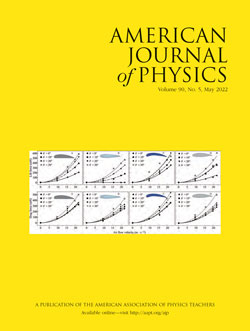 May 2022 Issue,
May 2022 Issue,
Volume 90, No. 5
Simple apparatus for demonstrating factors that influence lift and drag
Although the inaccurate explanation of lift based solely on the Bernoulli equation can still be found in textbooks, there are many places where interested readers can gain a correct understanding. However, it is complex and involves several physical phenomena. In this paper, we describe a simple device that can be used in teaching to support the understanding of the correct mechanism of the generation of lift either during lecture demonstrations or in undergraduate laboratory measurements.
EDITORIAL
In this issue: May 2022 by Mario Belloni, Craig Bohren, Harvey Gould, Raina Olsen, Beth Parks, Donald Salisbury and Jan Tobochnik. DOI: 10.1119/5.0092373
Special issue on teaching about the environment, sustainability, and climate change by Beth Parks and Gary White. DOI: 10.1119/5.0092653
A call for papers for upcoming special collections in both the American Journal of Physics and The Physics Teacher
RESOURCE LETTER
Resource Letter MDS-1: Mobile devices and sensors for physics teaching by Martín Monteiro and Arturo C. Martí. DOI: 10.1119/5.0073317
As the use of mobile devices (smart phones and tablets) has risen, so has their computational power and connectivity. In addition, with the inclusion of a broad array of built-in sensors, mobile devices can provide physics experimental apparatus to students, especially during the pandemic. This Resource Letter serves a guide for physicists interested in teaching a wide variety of experimental physics topics using the built-in sensors available in mobile devices.
PAPERS
Quantitative analysis of a smartphone pendulum beyond linear approximation: A lockdown practical homework by R. Mathevet, N. Lamrani, L. Martin, P. Ferrand, J. P. Castro, P. Marchou and C. M. Fabre. DOI: 10.1119/10.0010073
The clever mounting scheme for this smartphone pendulum reduces frictional loss (Q ∼ 500) and allows analysis within the simple harmonic oscillator (point mass) approximation. For more advanced students, the high quality of the accelerometer data enables students to apply increasingly refined data analysis techniques that quantify the small non-linearities in the system. This exercise was implemented as a take-home lab for undergraduate students but could also be appropriate for students in an advanced laboratory course who are learning about data analysis and model development.
Gravitational effects of ice sheets on sea level by Douglas A. Kurtze. DOI: 10.1119/5.0067924
Gravity can surprise you! The author considers the gravitational attraction between the Greenland and Antarctic ice sheets and the surrounding oceans. This attraction is great enough that, while the melting of the ice sheets would result in catastrophic average sea level increases of 7 m and 58 m respectively, the sea level on the shores of Greenland and Antarctica would actually decrease because of the decreased gravitational attraction. This effect is illustrated using a series of models of increasing complexity and accuracy, starting with a flat-earth point-mass model that could be presented in an introductory mechanics course and proceeding through more realistic models that make good use of Legendre polynomial expansions taught in introductory mathematical methods courses.
Simple apparatus for demonstrating factors that influence lift and drag by Leontýna Šlégrová and Jan Šlégr. DOI: 10.1119/10.0009681
This paper shows how to construct a simple apparatus that enables measurement of the lift and drag forces on an airfoil as functions of not only air speed but also the airfoil's profile and angle of attack
Electrically connected and magnetically coupled inductors: Aiding or opposing fluxes? by Josefina María Silveyra and Juan Manuel Conde Garrido. DOI: 10.1119/5.0067939
Inductors connected in series and parallel, taking mutual inductance into account, are rarely dealt with in introductory physics courses. Some surprising behaviors result from the relative orientations, and the resulting insights could potentially lead to interesting laboratory circuits and new applications.
Michelson interferometry with a diode laser by Abdulaziz M. Aljalal. DOI: 10.1119/5.0062798
Diode lasers are easily accessible in the teaching laboratory, and therefore are frequently used in Michelson interferometers. This paper shows that diode lasers can lase in multiple longitudinal modes simultaneously. Instructors of introductory labs will want to be aware of these multiple modes because they can result in interference signals that may confuse students, and instructors of more advanced optics labs may ask students to use the interferometer signal, possibly combined with high-resolution spectrometers, to study these modes.
Simulating epidemics via the theory of dynamical systems by Giorgio Mantica. DOI: 10.1119/5.0082825
The author discusses a deterministic agent-based version of an SIR (susceptible, infected, recovered) epidemiology model and discusses how it is related to the usual probabilistic model because the deterministic model is chaotic. The suggested simulations and problems embedded in the text guide the reader to an exploration of the model and underlying concepts such as chaos, ergodicity, and networks.
A note on Newton's shell-point equivalency theorem by B. Cameron Reed. DOI: 10.1119/5.0072584
We all know that the gravitational force due to a spherically symmetric mass is the same as if all its mass were located at a point at its center. That's Newton's shell-point equivalency theorem. But did you know that the equivalency also holds for the harmonic potential? Or that these are the only two potentials for which the equivalency holds? This brief note provides simple proofs of these statements, and also shows that, unlike the case of Newtonian gravity, the harmonic oscillator potential yields a non-zero force inside the shell.
BOOK REVIEW
About AJP
General Information, Resources for Authors, Reviewers, and Readers

